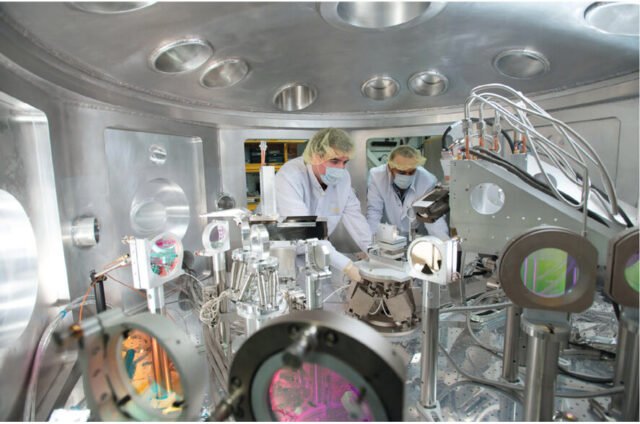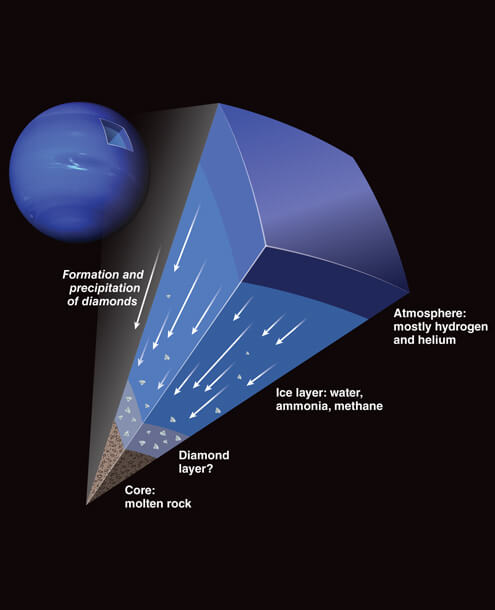Have you ever woken up from a very strange dream? A dream involving diamonds pouring from the sky? Falling on your roof on to the ground? But what if I tell you it’s not just a dream. This is real.
Yes, you read it right! It rains diamonds. But not on earth, unfortunately (or fortunately!). The diamond shower is an actual phenomenon in Neptune and Uranus!

Neptune and Uranus are huge “ice giants”. For many years, scientists have tried to research intensively about these planets. Being very distant, they are the most unexplored and inadequately studied major planets in our solar system. Voyager 2 is the only successful space mission that has managed to have approached these isolated celestial-bodies yet.
Published in the journal Nature, an experiment conducted by scientists has proven that the special atmospheres of Neptune and Uranus are ideal for the diamond shower.
Neptune and Uranus are called ice giants, but “ice” refers to hot slush-like materials, like water, ammonia and methane, over an Earth-sized rock core and lighter gases like hydrogen and helium below it.
Read More: Is It True That NASA Found Evidence Of A Parallel Universe Where Time Flows Backwards?
The experiment
The new experiment was conducted using the Stanford Linear Accelerator Center (SLAC) and the National Accelerator Laboratory’s Linac Coherent Light Source (LCLS) X-ray laser for precise measurements to demonstrate how the ‘diamond rain’ process should occur. They found that carbon transitions directly into the crystalline diamond.

The team exposed polystyrene, a type of plastic composed of carbon and hydrogen, to high-powered shock waves produced by an optical laser and X-rays. The shock waves highly compressed the plastic at pressures of 150 gigapascals and temperatures over 9,000 degrees Fahrenheit.
“We produce about 1.5 million bars, that is equivalent to the pressure exerted by the weight of some 250 African elephants on the surface of a thumbnail,” said Dr. Dominik Kraus, a scientist at Helmholtz-Zentrum Dresden-Rossendorf who led the study.

This enormous reaction broke the bonds between the hydrogen and carbon molecules and compressed carbon atoms into microscopic diamonds.
In the new study, scientists used a unique technique called “X-ray Thomson scattering” that allowed them to accurately replicate diffraction results whilst observing how the elements of non-crystal samples are mixed together.
This scattering technique helped the experimenters to reproduce the exact diffractions from hydrocarbons that split into carbon and hydrogen just like they would inside Neptune and Uranus. This resulted in crystalization of the carbon because of extreme pressure and heat. This leads to a downpour of diamonds 6,200 miles underground, gradually plummeting inside the planets’ cores.

“In the case of the ice giants we now know that the carbon almost exclusively forms diamonds when it separates and does not take on a fluid transitional form,” said Dr. Dominik Kraus.
He also added that “This technique will allow us to measure interesting processes that are otherwise difficult to recreate,” “For example, we’ll be able to see how hydrogen and helium, elements found in the interior of gas giants like Jupiter and Saturn, mix and separate under these extreme conditions.”
“It’s a new way to study the evolutionary history of planets and planetary systems, as well as supporting experiments towards potential future forms of energy from fusion.”
This newly discovered knowledge about the various processes on ice giants is anticipated to promote the search for planets that can endure life and help us to understand the solar system.
Image Source: Google Images
Sources: Science Alert, Sputnik News, All That’s Interesting
Find Blogger: @aditi_21gupta
This post is tagged under: science, astronomy, planets, Neptune, Uranus, Diamond, Diamond rain, Raining, ice giants, Solar System, space, Voyager 2, NASA, experiment, celestial bodies, physics, Earth




































